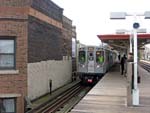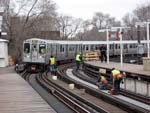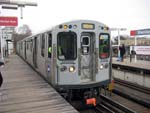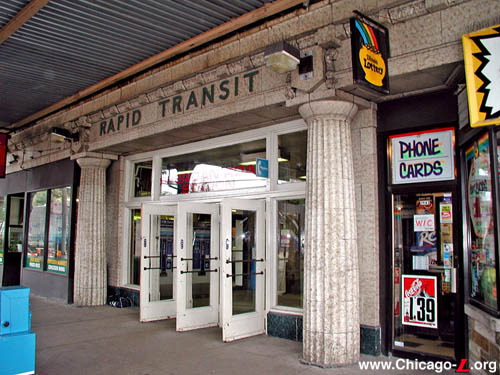
The front of Sheridan station is seen looking west on August 10, 2004. The beaux-arts elements typical of many of Arthur Gerber's rapid transit stations are evident -- as well as the use of Doric elements in the twin fluted columns -- but unfortunately the original lights have been replaced. For a larger view, click here. (Photo by Graham Garfield) |
Sheridan
(4000N/1000W)
Sheridan Road and Irving
Park Road, Lakeview
Service
Notes:
|
Red Line: Howard |
|
Owl Service |
Quick Facts:
Address: 3940 N. Sheridan
Road
Established: May 31, 1900
Original Line: Northwestern Elevated Railroad
Previous Names: none
|
Skip-Stop Type:
|

|
Station
|
Rebuilt: 1916 (station house expanded, renovated), 1930 (station house renovated)
Status: In Use
History:
Sheridan was built as part of the original main
line of the Northwestern Elevated in 1900. The only line in Chicago
to do so, the Northwestern "L" built four tracks north of Chicago
Avenue to allow for both local and express service. Some stations
were built with platforms on the outside tracks (for locals only),
but some, like Sheridan, had two island platforms to facilitate both
express and local trains.
The original brick station house was similar
to those still at Chicago, Sedgwick, Armitage, Fullerton, Diversey, and Belmont. Their architecture was standard for brick ground-level station houses built on what was the Northwestern mainline. They were designed by William Gibb and constructed entirely of brick with terra-cotta trim and stone. The bold modeling of the details is characteristic of Italianate work of the late 19th century, though these station might better be classified as Classical Revival. The building, which was square in floor plan, featured unglazed terra cotta pilasters with composite capitals on either side of the front center entrance and on either end of the front facade. The front elevation had a heavy cornice with egg and dart molding and other classical ornamentation. The interior featured plaster walls with extensive wood detailing in the door and window frames, ceiling moldings, and tongue-in groove chair rail paneling.
Wooden stairs on steel supports with
decorative metal railings led from the Sheridan station house to the
dual island platforms. Under the Northwestern Elevated's
configuration, Sheridan was an express/local station where both
classes of trains stopped and passengers could make cross-platform
transfers between the two. The outside tracks were the local tracks,
while the inside tracks were for express trains. The island
wood-decked platforms are covered in the center by two peaked-roof
canopies of steel supports with a gently-curved bracket and intricate
latticework, covered by hipped corrugated metal roofs. The canopies
covered about half the platform length, but the platforms were
subsequently lengthened multiple times to allow longer trains to
berth. The original railings, which Sheridan only had around the
stairs and at the platforms' ends since there never side railings due
to the island configuration, consisted of tubular railings and posts
with panels of decorative, ogee patterned metalwork
inside.
Renovations

The interior of the Sheridan station is seen looking west on November 13, 1956. The art marble walls, terrazzo floors, and decorative ticket agent's booth and light fixtures date from the station's 1930 renovation. For a larger view,
click here. (Photo from the Graham Garfield Collection) |
An expansion of Sheridan station was undertaken in 1916. It is unclear exactly what form the work took, and how extensively the 1900-built station house was modified or reconstructed. However, the work was designed by company architect Arthur U. Gerber and the expansion
included additional waiting room space on both sides of the entry and
a new brick facade. Work was evidently completed in 1917.
Sheridan station was again remodeled a
decade and half later. Arthur Gerber, by now the Chief Architect for
the Chicago-area electric railroads controlled by Samuel Insull
including the Chicago Rapid Transit Company, designed the new
facility in 1929 with the construction work carried out in 1930. This
renovation work kept some of the station house's structure but
completely renovated the facade and interior and repurposed some of
the spaces. The side waiting rooms were converted into retail spaces,
while the central corridor was remodeled into the waiting room and
fare control area.
The new facade and interior, which was very
similar to the Central and South Boulevard stations on the Evanston line, was typical of a series of designs executed by Gerber during this period. The front elevation combines elements of Doric and Beaux Arts designs, executed in terra cotta. Trademark Gerber details include the laurel-framed cartouches, a pair of Greek Revival Doric columns framing the entrance, gloved lights and the words "Rapid Transit" above the door in terra cotta.
The interior was executed in smooth stone
with a spacious fare control area, with terrazzo flooring and "art
marble" and plaster walls. On the street elevation, two retail spaces
were provided on either side of the entrance. In later years, an
enclosed concession space was added in the unpaid area of the
interior along the north wall. Over the years, Sheridan has remained
somewhat historically intact, with its original floors, wood
moldings, and decorative agent's booth. Other features, however, such
as the original exterior gloved lights and some ornamentation has
been lost. The terrazzo floor has also become deteriorated over the decades.
During both renovations the platforms were
not rebuilt or substantially altered, except for being lengthened to
accommodate longer trains.
Changes in the
CTA Era
The stopping patterns of express trains on
the North Side Division changed many times over the decades between
the beginning of operations in 1900 and the assumption of operations
by the Chicago Transit Authority in 1947. Some classes of expresses
no doubt continued to serve Sheridan station during this period,
although there is evidence to suggest that many bypassed the station
and that Sheridan was served largely by local trains by
mid-century.
Sheridan became an "A" station under the
skip-stop
express system instituted on August
1, 1949. Under the new North-South service scheme instituted in 1949,
Howard trains ran local on the inside former "express" tracks
(Tracks 2 & 3) and Evanston Express trains ran express on the outside former "local"
tracks (Tracks 1 & 4). Therefore, while Sheridan's island
platforms could still serve all four tracks, only Howard trains on
the inside tracks stopped at the station, while trains on the outside
tracks bypassed the station under normal operations, effectively
making Sheridan's island platforms function as side platforms. The
station reverted to an all-stop for North-South trains when A/B
service was discontinued in 1995.
Today, Red
Line trains use the inside tracks
and service the station, while Purple
Line Express trains use the outside
tracks and bypass the station. Trains occasionally stop at the
station on the outside tracks during reroutes or during special
operations such as charters.
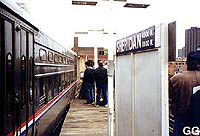
6000-series car 6655 rounds the corner at Sheridan station on May 6,
2001 while on IRM's PCC fantrip. Looking east on the northbound island platform,
the last of the CRT's blue and white enamel station name
signs on the "L" system remains on a wooden windbreak at the
east end of the platform. For a larger view, click here. (Photo by Graham Garfield) |
Sheridan was the last station on the entire "L" system that still
had an old-style CRT-era blue and white enamel station name sign in
place, located on the north side of the last wooden partition on the
east end northbound platform. It was also visible from the street
below. (There was also a CRT-era sign for DePaul University at Fullerton and other smaller auxiliary
signs of that era at various Ravenswood, Evanston, Howard,
and Loop stations but this was the last old-style station name sign.)
In May 2002, the Live Bait Theater "adopted" the Sheridan station as
part of the CTA's Adopt-A-Station program. Participating in the adoption ceremony were
CTA President Frank Kruesi and
Live Bait Theater Artistic Director Sharon Evans, along with other
elected officials and community representatives. The adoption of the
Sheridan station by the Live Bait Theater included a visual tribute
to Chicago writers, with murals installed throughout the station that
featured short literary quotes inspired by notable Chicago writers who
found poetic inspiration as they rode the trains, including Ben
Hecht, Carl Sandburg, Edna Ferber and Richard Wright. The designs and
murals were by Mary Griswold. The Chicago writers' portraits weer by
Steve Musgrave. Mr. Musgrave is the same artist who adopted the
Red Line station at
Addison.
As part of a general cleanup of the station in preparation for the
station to be adopted, all nonstandard, damaged, and out-of-date
signage was removed. This included the aforementioned blue and white
porcelain enamel station name sign at the east end of the northbound
platform, facing Track 4, that dated from the days of the Chicago
Rapid Transit Company circa the 1920s.
Sheridan was included in the
CTA's "Front Door Program", an
initiative to add amenities and make aesthetic improvements to
station entrances throughout the rail system. At its June 4 , 2003
monthly meeting, the Chicago Transit Board approved a $569,973
contract for Chicago-based Camp Dresser & McKee, Inc. (CDM) to
design and prepare construction bid documents for the Front Door
Program, which includes seven stations (Sheridan included).
Upgrades at the seven stations were to include station identification
signage, new fencing, reconfigured turnstiles, improved lighting and
heating systems, benches/street furniture, improved bus waiting areas
and bus information panels, landscaping and windbreaks, though not
all seven locations were to receive all of these improvements. Funding
for this contract was provided by the FTA and the Regional
Transportation Authority (RTA). The improvements were designed but never performed, with the project funds diverted to other needs. A viaduct-mounted identifier design, with a backlit CTA logo, designed for Sheridan was never installed, but was later used at the Cermak-Chinatown station in renovations completed in 2011.
In Fall 2005, the Chicago Cubs adopted the Sheridan station as
part of the CTA's Adopt-A-Station program. Cubs officials, local elected officials and
Chicago Transit Authority representatives dedicated the adoption at
the station on October 3, 2005. The Cubs commissioned Gallery 37 to
create two pieces of art for the station that depict the culture of
the Cubs and the surrounding neighborhood. The two pieces, 8.5 feet
by 7 feet and 3 feet by 15 feet were created by 26 students in the
gallery's innovative Center for the Arts eight week summer arts
program during summer 2005. The artwork hangs on the north and south
walls in the station's unpaid area. The Cubs chose to adopt Sheridan
because Chicago artist Steve Musgrave adopted the Addison
station, next to Wrigley Field, in 1998.
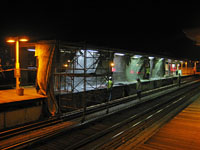
Crews have erected scaffolding and hung tarps to begin overnight painting work on the canopy at Sheridan on the evening of September 24, 2012. The paint the portions over or close to Tracks 2 and 3, Red Line trains were diverted to Tracks 1 or 4 overnight. For a larger view, click here. (Photo by Graham Garfield) |
In 2006, the station name signs and column signs on the platform
were replaced, with Green Line
Graphic Standard signs replacing the KDR
Standard graphics, and new entrance signs installed as part of a
signage upgrade project on the Red Line. As part of this effort, the
station also received a granite compass rose inset into the sidewalk
in front of the station entrance to assist customers leaving the
station to navigate their way, and three-sided galvanized steel
pylons on the platforms to display maps and
station timetables.
On September 20, 2011, Chicago Mayor Rahm Emanuel and CTA President Forrest Claypool announced a new CTA station renewal initiative designed to provide a facelift to 100 CTA rail stations over the following 12 months. The initiative, performed by work crews called the 'Renew Crew' comprised of different trade workers, focuses on providing repairs in a more efficient way, creating a cleaner, brighter and more appealing station that improves the customer travel experience. Different stations received different scopes of work depending on their needs and the available resources, but generally fell into two categories: basic renewals and expanded renewals. Sheridan received an "expended renewal' in late Summer and Fall 2012, and as part of the work crews removed the years of old paint and prepped, primed and painted the platform canopies, including the columns, base plates and guardrails, inside faces of platform support stringers, and corrugated metal roofing. Other work at the station included repainting the elevated track structure over the street, including the stringers and support columns, painting other elements within the station, cladding the existing 1920s-vintage wooden Customer Assistant booth in stainless steel, and repairing and patching a large hole in the station house's plaster ceiling.
As CTA continued the Wilson Station Reconstruction Project, track 1 -- the westernmost, southbound Purple Line Express track -- was closed for demolition over the weekend of March 6, 2015. This began a multi-year period of three-track operations through Wilson station, similar to the operations for construction phasing that took place at Belmont and Fullerton in 2007-08 for those stations's reconstruction. Three-track operations began Monday, March 9, 2015.
Southbound Red Line and Purple Line Express trains share a single track -- track 2 -- between Lawrence and Belmont for one year, with Purple Line trains merging onto track 2 through a new crossover at Leland whose installation was completed over the weekend before three-track operations began. Although the right-hand crossover from track 2 back to track 1 at Montrose is outside of the construction zone and remained in service, it is a non-interlocked hand-throw switch, making its use to re-sort trains slow and likely to cause excessive delays given the close headway of the combined Red and Purple lines. As such, Purple Line trains were kept on track 2 all the way to Clark Junction, where they were sorted back onto track 1 by the tower. Because they were on the same track as the Red Line, and might likely catch up to their Red Line leader on the same track if they ran express, as well for added customer convenience, Loop-bound Purple Line Express trains added stops at the Wilson, Sheridan and Addison stations during this phase of the project, but during morning rush only. Loop-bound trains in the evening rush, as well as all Linden-bound trains, continued to bypass those three stations. CTA took the opportunity of track 1 being closed through Sheridan to perform track renewal between Montrose and and Addison, laying all new ties, rails and other track systems in the area. In addition, ironworkers performed structural maintenance on the elevated structure.
On Monday, March 21, 2016, the Wilson Station Reconstruction Project moved into phase 2. At that point, the new track 1 opened through Wilson station and southbound Red and Purple Line trains moved to using this track. They remained on track 1 through Sheridan station, resulting in trains stopping on the outer side of the southbound island platform instead of the inner side. At Addison Interlocking, north of Addison station, Red Line train were sorted and moved back onto track 2 to call at Addison, but Purple Line trains remained on track 1, as they had before. As they had in phase 1, CTA took the opportunity to perform rehabilitation work, with ironworkers performing structural maintenance on the elevated structure and platform supports. The platform was fenced off down the middle to protect the work area, and platform furniture like windbreaks and benches were flipped to face track 1 instead of track 2. The fencing was removed in time for rush hour on Monday, September 12, 2016, following the completion of structural maintenance work in the out of service area, but all southbound trains remained on track 1 into 2017 as work continued at Wilson.
Proposed Renovation
On April 27, 2012, Mayor Emanuel, Governor Quinn, Senator Durbin, Congresswoman Schakowsky, and Congressman Quigley announced that the Sheridan station is slated to receive approximately $17 million for major renovations.1 The announcement did not elaborate on what the scope of the renovation project would be.
The Sheridan station renovation is a part of a $1 billion overhaul that includes federal, state and local funding sources for the Red Line from its northern end to the 95th/Dan Ryan station, including the complete reconstruction of the Wilson station one stop to the north.2

The dual island platforms at
Sheridan, looking east on March 31, 2007. These platforms, little
changed since this station opened 99 years before, were made
to service both sets of tracks, as Sheridan was designed to
be an express/local station. Now, the outside tracks are
used by Purple Line Express trains -- which do not call at
Sheridan -- and the island platforms act as side platforms
for Red Line service. For a larger view, click here. (Photo by Graham Garfield) |

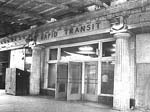
|
sheridan01.jpg (141k)
Sheridan in 1985. The laureled cartouches and paired columns are typical of Beaux-Arts architecture and of Gerber's "L" station designs. (Photo by Olga Stefanos) |

|
sheridan_signSB.jpg
(68k)
Circa the 1980s, when Sheridan station received KDR-type
signage, the platform received these "symbol signs". This
sign's mention of A/B skip-stop service is now out-of-date,
as A/B service was annulled on the Howard Line in 1995. The
red color of the sign comes from a color-coding of signage
under the KDR
scheme, with A stations being red. (Sign
from the Andrew Stiffler Collection)
|
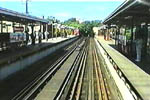
|
sheridan02.jpg
(116k)
The Sheridan station looking west from a
Howard-bound train in the early 1990s. The two platforms
serving four tracks harks back to its days as an express
station on the Northwestern Elevated.
(Photo from Chicago's "L"/Subway
System: Take a Ride on the Wild Side from
All-the-6000s-You-Missed Productions)
|
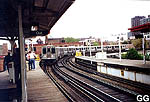
|
sheridan03.jpg
(82k)
An eight-car northbound Red Line train of
rehabbed 2600-series
cars rounds the corner at Sheridan and Dakin, heading into
Sheridan station on May 6, 2001. (Photo by
Graham Garfield)
|
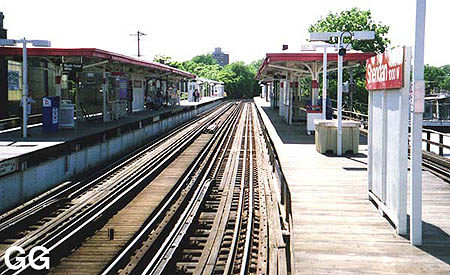 |
sheridan05.jpg (79k)
The dual island platforms at Sheridan, looking west in 1999. (Photo by
Graham Garfield) |
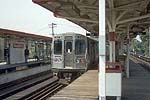
|
cta2644.jpg
(84k)
Car 2644 trails a Red Line train stopping on the
inner "express" tracks at Sheridan -- with its dual island
platforms for express/local service -- on August 22, 2001.
(Photo by Mike Farrell)
|

|
cta2646b.jpg
(69k)
Leaving Sheridan station on its way downtown, car
2646 is on the back of a southbound Red Line of rehabbed
2600-series cars on
August 22, 2001. (Photo by Mike
Farrell)
|
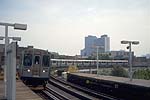
|
cta2697.jpg
(63k)
An 8-car Red Line train heads through the curve
north of Dakin Avenue and into Sheridan station, with car
2697 in the lead on August 22, 2001. (Photo
by Mike Farrell)
|
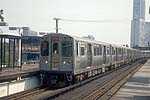
|
cta2722a.jpg
(78k)
An 8-car northbound Red Line train stops at
Sheridan station, led by car 2722, on August 22, 2001. The
destination sign reading "95/Dan
Ryan" sign is incorrectly set. Though it may or
may not be the operator's error, it will only confuse
passengers; the markers are the same in either direction, so
towermen will be unfazed by the error.
(Photo by Mike Farrell)
|
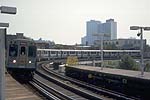
|
cta2910b.jpg
(75k)
A long 8-car Red Line train of 2600-series
cars, led by car 2910, travels through the Sheridan S-curve
into Sheridan station, heading north on August 22, 2001.
(Photo by Mike Farrell)
|
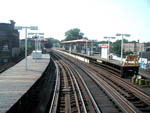 |
sheridan07.jpg (162k)
The Sheridan station platforms are seen looking west on September 3, 2001 from around the curve east of the station. The station's original platforms from 1900 were only around the short canopies in the middle of the platforms. The platforms were later extended to accommodate longer trains, barely able to reach the length needed for 8-car trains -- CTA's longest, typically -- before beginning to bend into the curves that bookend the station, something undesirable from both an operational and safety standpoint. (Photo by
Graham Garfield) |
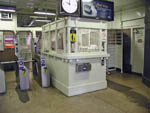 |
sheridan08.jpg (165k)
The fare array inside the Sheridan station house is seen from the unpaid area on July 5, 2002. The Customer Assistant booth, built originally for ticket agents, was originally varnished wood with decorative glass and wood, and dates from the station's 1930 renovation, as do the terrazzo flooring, marble wall cladding, and annunciator boxes in the background. Many other changes, such as the flooring patches, modern turnstiles, and advertising have been layered on over the decades. (Photo by
Graham Garfield) |
 |
sheridan11.jpg (144k)
This September 26, 2007 view looks southwest across Sheridan Road at the Sheridan station facility, with the 1930-remodeled station house below and the 1900-built platforms and canopies above as a northbound Red Line train enters the station. Several signage improvements from the 2006 Red Line Wayfinding project are visible in this view, including the Green Line
Graphic Standard station name sign above and backlit station entrance sign underneath the elevated structure. (Photo by
Graham Garfield) |
|
cta5008a.jpg (164k)
For several months, the 5000-series prototype railcars were tested on the various lines, running out of service but with proper signs and markers and opening their doors at each station (though on the side opposite the platform, so as not to confuse and errantly board any wayward customers). An 8-car train is led by car 5008 running as "Run 802" to 95th at Sheridan station on November 11, 2009. (Photo by Graham Garfield) |
|
cta5004a.jpg (179k)
An 8-car train of prototype 5000-series railcars, led by car 5004, is rounding the curve west of Sheridan station while running in nonrevenue testing service on the Red Line on March 15, 2010. Workers on the tracks are completing tie renewal work that had been underway for many months in this area. (Photo by Graham Garfield) |
|
cta5004b.jpg (140k)
Car 5004 leads an 8-car train of prototype 5000-series railcars at Sheridan station on March 15, 2010. The cars are running in nonrevenue testing service on the Red Line. Because they're running with real destination signs, the cars have a "Test Train" sign taped to the front window to warn passengers that the train is not in service. Compare that to the train four months earlier, using Instruction Train signs to warn customers. (Photo by Graham Garfield) |
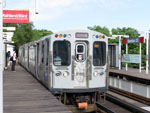 |
cta5195.jpg (220k)
During the Red Line South Reconstruction Project, with the Dan Ryan branch closed Red Line trains were rerouted to Ashland/63rd via the South Side Elevated. However, during rush periods the number of Red Line trains needed to service the north half of the line and number of Green Line trains needed to serve the Lake branch would have exceeded the capacity of the South Side "L", so some trains were turned back downtown. During the morning rush, certain Red Line trains only operated as far south as Roosevelt. Car 5195 leads an 8-car train pulling into Sheridan station on July 10, 2013, bearing a Roosevelt destination sign slightly washed out in the morning sun. (Photo by Graham Garfield) |

- Sheridan_next.wav
(119k): "Sheridan is next. Doors open on the right at
Sheridan." (Sound
courtesy of Tony Coppoletta)
Notes:
1. 46th Ward Aldermanic Office. "Alderman Cappleman, 46th Ward Applauds Funding for Sheridan Red Line Station" [press release]. 27 April 2012.
2. Ibid.





















